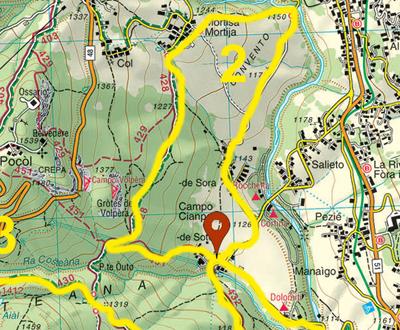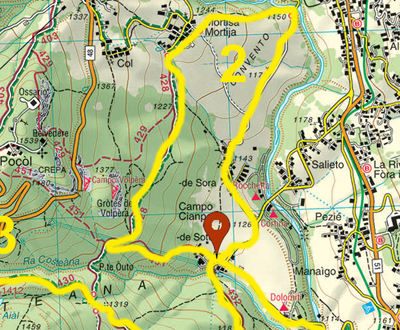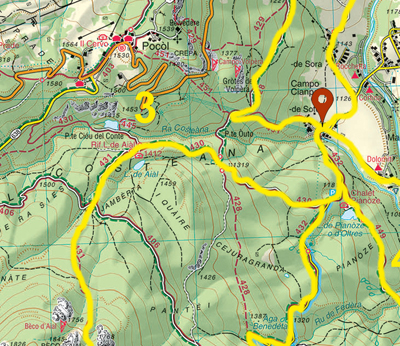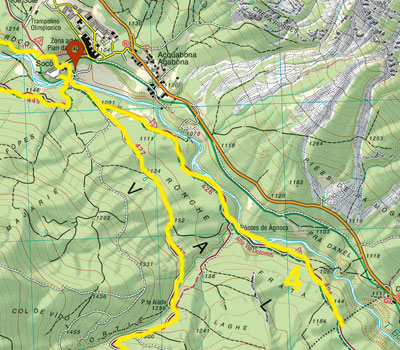Valley
Itineraries

Pian de ra Špines
Pian de ra Špines

The alluvial plain formed by the Boite north of Cortina is a natural area where the landscape changes and renovates at each flood and course diversion of the river. In this stretch, waters are clear and free to run on a wide bed of rock debris. The trail that circumnavigates Pian de ra Špines, is suitable for many sports activities and accessible to disabled.
Length: 8.000 m.Vertical gain: 100 m.
Time required: 2 ore
×

Loop of Col Rosà
Loop of Col Rosà

On the eastern slopes of Col Rosà, towards the Boite, beech trees ascend the slopes encouraged by the sirocco current rising from the valley floor and form a strip of pristine beech forest. On the opposite side, where low temperatures of the gorge climate prevail, stone pines are found at low altitudes. Easy trails lead around the entire mountain to appreciate the different eco-systems and the geomorphological peculiarities of Campanile Rosà and the gorge of Ru de ra Vales.
Length: 12.500 m.Vertical gain: 430 m.
Time required: 3,5 ore
×

Mietres
Mietres

Sparse, bright forests of Scotch pines and larches cover the sunny slopes at the base of Mt. Pomagagnon. The Mietres area is where hay meadows were found at higher altitudes in the valley before being abandoned and conquered by woods. The area is still open today, with panoramic views and rich in all the flora and fauna that prefer wood edges and marginal environments.
Length: 4.000 m.Vertical gain: 450 m.
Time required: 3 ore
×

The forest of Lariéto
The forest of Lariéto

Perhaps one of the most frequently photographed larch forests of the Alps for the perfect regularity of the tree trunks of pure larch and the cleanness of its floor. The evolution of this forest of spectacular beauty has been maintained in its current condition through continuous, constant cattle grazing of the undergrowth. Its natural destiny is to be replaced in time by a mixed forest of fir trees and stone pines, which only man's perpetual intervention may slow down.
Length: 3.600 m.Vertical gain: 180 m.
Time required: 2 ore
×

Màndres
Màndres

The forest of Mandres is a bright, sparse larch wood that is gradually evolving towards a spruce forest since cattle grazing has been gradually abandoned. It is rich in fauna, mainly woodpeckers and owls, and crossed by several fascinating hiking routes. A panoramic trail on the above scree and mugo-pine, where Dianthus sternbergii and Cypripedium calceolus abound, connects Lariéto to Fraìna.
Length: 3.50 m.Vertical gain: 50 m.
Time required: 2 ore
×

Lago Ghedina - In Pó Drušié
Lago Ghedina - In Pó Drušié

The hill of ra Sponàtes, next to Col Drušié, is covered with a thin coniferous forest, showing little of man's intervention and inhabited by several species of galliformes. The hill can be travelled around its base, walking by Lago Ghedina and along a winding, convenient military road. The lake is a wonderful water expanse that fills a basin at the back of one of the hills that originated with the post glacial landslides of Tofana.
Length: 5.200 m.Vertical gain: 220 m.
Time required: 2,5 ore
×

Volpèra caves
Volpèra caves

This unique area created in the post-glacial age by a huge collapse of Cyclopean boulders, from the erosion of the rocky block of Crepa di Pocol following the thawing of the valley floor glacier. In the last millennia, the moraine has been covered by a mixed forest of conifers and beech trees, with little intervention by man it has developed abundant moss and lichens and is populated by several species of woodpeckers and birds of prey. The caves are actually passages under the boulders piled up and are not due to Karst phenomena.
Length: 3.800 m.Vertical gain: 250 m.
Time required: 2,5 ore
×

Lago d'Ajal - Ciou del Conte
Lago d'Ajal - Ciou del Conte

The trail through the beautiful forest of Peronàte leads to Lago d'Ajal, an amazing lake with clear waters, formed through damming by a small moraine bar where Ranunculus trichophyllus is found. Farther on, along the Costeana stream, there are hydroelectric plants, as the Ciòu del Conte dam. To avoid the last stretch, return to Lago d'Ajal on the same path.
Length: 3.800 m.Vertical gain: 150 m.
Time required: 2 ore
×

Lago d'Ajal
Lago d'Ajal

Lago d'Ajal is an enchanting natural lake with clear waters formed through damming by a small moraine bar, where Ranunculus trichophyllus is found. Ajal and Fedéra forests, though apparently uniform, are dotted with springs and wet areas and gorges with deep rock crevices, like the Cuaire , just above the lake. These scarcely visible areas create extremely varied habitats favourable to biodiversity.
Length: 1.500 m.Vertical gain: 120 m.
Time required: 1 ore
×

Lago di Pianòzes - Socol
Lago di Pianòzes - Socol

Lago di Pianozes is a small lake exclusively devoted to tourism, partly natural and partly created by a barrage. The excellent quality of its waters and shores is testified by the presence of Persicaria amphibia, a rare semi-aquatic plant whose distribution in Ampezzo is limited to this lake. The spruce forests at the foot of the slopes on the orographic right of Costeana and Boite streams are among the most fertile and impressive in Cortina. Managed at low impact, they are inhabited by the capercaille (Tetrao urogallus) and the goshawk (Accipiter gentilis)
Length: 5.000 m.Vertical gain: 100 m.
Time required: 2 ore
×

Val d'Ortié - Fedèra
Val d'Ortié - Fedèra

This valley, almost entirely wooded, rises from the beech forests of the valley floor to the upper limit of the woods for one thousand metres of vertical gain. It is crossed by a pristine torrent that flows through deep, spectacular gorges and waterfalls. The valley, among the wildest and least affected by man in Cortina, is rich in flora and fauna, mainly on the peat bogs of its lower part. A veritable oasis of wilderness in the Ampezzo Dolomites
Length: 15.200 m.Vertical gain: 1.000 m.
Time required: 5,5 ore
×

The Boite riverbank – San Vito border
The Boite riverbank – San Vito border

Beyond Socol bridge, the Boite river flows freely and copiously for a few kilometres as far as San Vito, self-regenerating and creating interesting river bank environments and willow woods. The foot of the orographic right slope is covered with a thick mixed forest - with residual yew trees (Taxus baccata) - which hides rocky ravines where eagle owl (Bubo bubo) nests, and well-preserved peat bog rich in rare species; among which are Drosera rotundifolia and Epipactis palustris.
Length: 3.000 m.Vertical gain: 120 m.
Time required: 1,5 ore
×